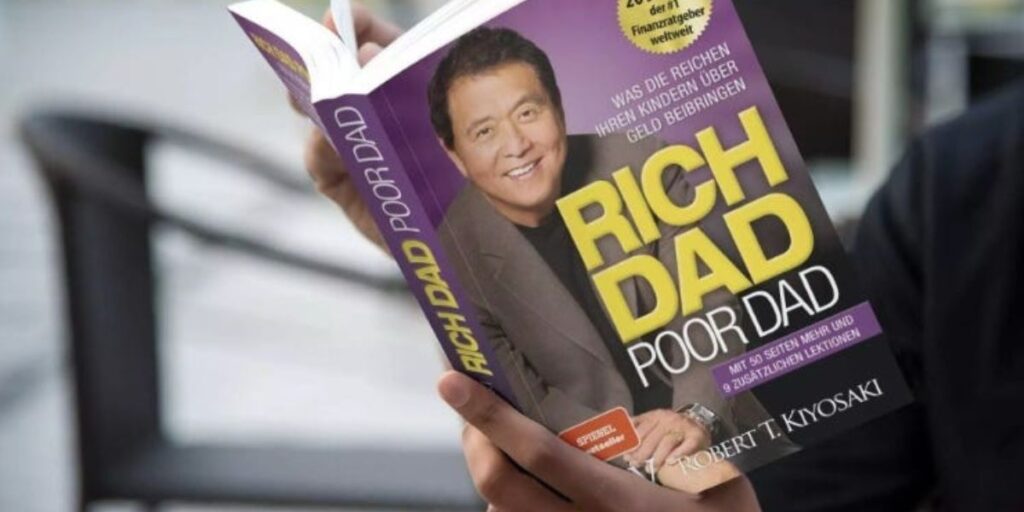Rich Dad Poor Dad,” written by Robert T. Kiyosaki, is more than just a best-selling personal finance book. It has become a timeless classic, inspiring millions worldwide to rethink their approach to money and success.
In this article, we delve into ten powerful life lessons extracted from the pages of “Rich Dad Poor Dad” that have the potential to transform your perspective on wealth, financial independence, and achieving your dreams. These insights offer a roadmap to building a prosperous future and breaking free from the constraints of traditional thinking.
So, let’s embark on this transformative journey and uncover the wisdom that can lead you towards a more abundant and fulfilling life
Table of Contents
Who is Robert Kiyosaki?
Robert Kiyosaki is a renowned entrepreneur, investor, educator, and best-selling author. Born on April 8, 1947, in Hilo, Hawaii, Kiyosaki’s life experiences and financial insights have made him a global authority on personal finance and wealth creation.
After graduating from the United States Merchant Marine Academy, Kiyosaki served in the U.S. Marine Corps and later ventured into various entrepreneurial endeavors. He gained practical experience through successful business ventures and financial setbacks, which shaped his understanding of money and investing.
Kiyosaki’s unique perspective on wealth was profoundly influenced by two father figures in his life – his biological father (referred to as “Poor Dad”) and the father of his best friend (referred to as “Rich Dad”). While both men were influential in their own ways, their differing financial philosophies led Kiyosaki to recognize the critical importance of financial education and how it shapes one’s financial future.
Overview of the Book
Published in 1997, “Rich Dad Poor Dad” is a groundbreaking personal finance book that challenges conventional beliefs about money and offers a fresh approach to building wealth. The book is not merely a how-to guide on investing; instead, it focuses on transforming the reader’s mindset and understanding the fundamental principles that govern financial success.
The central theme revolves around the contrast between the financial philosophies of Kiyosaki’s two father figures. His “Poor Dad” represented the traditional approach to money – going to school, getting good grades, and pursuing a stable job with a steady paycheck. On the other hand, his “Rich Dad” embodied a different perspective – emphasizing financial education, investing, and entrepreneurship as paths to financial freedom.
Through captivating anecdotes and real-life experiences, Kiyosaki shares the key lessons he learned from his “Rich Dad,” which challenged his beliefs and paved the way for his own financial transformation. The book is filled with actionable insights that encourage readers to question their existing financial beliefs and adopt a more proactive and informed approach to managing their finances.
“Rich Dad Poor Dad” outlines ten powerful lessons, each building upon the previous one, guiding readers towards a new way of thinking about money and wealth creation. From debunking myths about assets and liabilities to emphasizing the importance of financial literacy and entrepreneurship, the book offers a roadmap to financial freedom and a life of abundance.
Stay with us as we dive deeper into each of these life-changing lessons from “Rich Dad Poor Dad,” and discover how you can apply them to transform your financial future and achieve your dreams. This book has the potential to shift your mindset and set you on a path of financial prosperity and personal fulfillment.
So, let’s begin this transformative journey together.
Lesson 1: The Importance of Financial Education
One of the most crucial lessons from “Rich Dad Poor Dad” is the significance of financial education. Kiyosaki emphasizes that traditional education rarely teaches individuals about money management, investing, and building wealth. Instead, it tends to focus on academics and preparing students for a job in the “Rat Race.”
To break free from the limitations of a traditional mindset, Kiyosaki urges readers to seek financial education outside the classroom. By actively learning about assets, liabilities, cash flow, and investing, individuals can gain the knowledge and confidence needed to make informed financial decisions.
Financial education empowers individuals to understand how money works, spot lucrative opportunities, and navigate economic challenges. With a solid foundation in financial literacy, one can develop a more strategic approach to money, ultimately leading to a life of financial independence and abundance.
Lesson 2: Working for Money vs. Making Money Work for You
In “Rich Dad Poor Dad,” Kiyosaki introduces a powerful distinction between two mindsets – working for money and making money work for you. Many individuals spend their lives trapped in the “Rat Race,” wherein they work tirelessly to cover their expenses but fail to achieve financial freedom.
To escape this cycle, Kiyosaki advocates shifting focus from merely earning a paycheck to creating passive income streams. Passive income, such as earnings from investments, real estate, or businesses, allows money to work for you, generating income even when you’re not actively working.
By adopting the mindset of making money work for you, individuals can break free from financial constraints and attain the freedom to pursue their passions and interests, without being solely dependent on a paycheck.
Lesson 3: Mind Your Own Business
One of the fundamental principles taught in “Rich Dad Poor Dad” is the power of entrepreneurship. Kiyosaki emphasizes the importance of taking control of your financial destiny by starting and running your own business.
Entrepreneurship offers the opportunity to build assets that generate income and create wealth. By minding your own business and being your own boss, you can have greater control over your financial future and potential for unlimited earning.
Additionally, entrepreneurship provides a platform to explore and develop new skills, foster creativity, and build a strong network of like-minded individuals. By embracing the entrepreneurial spirit, individuals can step closer to achieving financial independence and living life on their terms.
Lesson 4: The History of Taxes and the Power of Corporations
In “Rich Dad Poor Dad,” Kiyosaki sheds light on the significance of understanding the tax system and its impact on personal finances. While employees and self-employed individuals often bear the brunt of heavy taxation, corporations can offer potential tax advantages and asset protection.
By forming corporations or using legal tax strategies, individuals can reduce their tax burden and retain more of their hard-earned money. Kiyosaki encourages readers to educate themselves on the tax laws applicable to their financial situation and leverage them to their advantage.
Furthermore, incorporating a business can shield personal assets from business liabilities, providing an added layer of protection. By understanding and utilizing the benefits of incorporation, individuals can pave the way for long-term financial stability and growth.
Lesson 5: The Rich Invent Money
Kiyosaki highlights the entrepreneurial mindset of the wealthy in “Rich Dad Poor Dad.” He emphasizes that the rich often seek out and create money-making opportunities rather than relying solely on a fixed income.
This lesson revolves around spotting opportunities and taking calculated risks to innovate and generate wealth. Successful investors are not afraid to step outside their comfort zone, invest in their ideas, and take advantage of favorable market conditions.
By developing the ability to recognize opportunities and being open to taking risks, individuals can emulate the mindset of the wealthy and create their own path to financial success.
Lesson 6: Work to Learn, Not to Earn
“Rich Dad Poor Dad” advocates a lifelong commitment to learning and self-improvement. Kiyosaki encourages individuals to invest in themselves by acquiring valuable skills and knowledge continuously.
Rather than focusing solely on earning a paycheck, the book suggests viewing work as a means to learn and gain experience. This learning-centric approach enables individuals to stay adaptable and relevant in a rapidly evolving world.
Gaining new skills and knowledge equips individuals with the tools needed to navigate economic changes and seize opportunities. A commitment to lifelong learning opens doors to personal growth, career advancement, and financial prosperity.
Lesson 7: Overcoming Obstacles and Failure
In “Rich Dad Poor Dad,” Kiyosaki emphasizes the importance of developing resilience and learning from failures and setbacks. He believes that obstacles are part of the journey to success and should be seen as valuable learning experiences.
The mindset of resilient investors involves staying committed to long-term goals and maintaining a positive outlook, even during challenging times. By learning from mistakes and setbacks, individuals can grow stronger and make better financial decisions in the future.
The book encourages readers not to be deterred by failures but to view them as stepping stones to success. Embracing a growth mindset enables individuals to bounce back from setbacks and continue moving forward on their financial journey.
Lesson 8: Achieving Financial Independence
Setting clear financial goals is a critical aspect of achieving financial independence. In “Rich Dad Poor Dad,” Kiyosaki advises readers to define specific, measurable, achievable, relevant, and time-bound (SMART) financial goals.
By setting realistic and attainable objectives, individuals can develop a well-defined path to financial freedom. Having clear goals allows them to track progress, make necessary adjustments, and stay motivated on their financial journey.
In addition to goal-setting, “Rich Dad Poor Dad” encourages readers to create a financial plan that aligns with their objectives. A comprehensive financial plan takes into account income, expenses, investments, and contingencies, providing a roadmap to achieve financial security and independence.
Lesson 9: Giving Back to Society
Beyond accumulating wealth, “Rich Dad Poor Dad” stresses the importance of giving back to society. Kiyosaki emphasizes that financial success should not be a selfish pursuit, but rather an opportunity to make a positive impact on others.
The book encourages readers to support charitable causes and contribute to their communities. Giving back can be in the form of financial donations, volunteering time and skills, or supporting social initiatives that align with personal values.
Through acts of philanthropy, individuals can experience a sense of fulfillment and purpose, knowing that their success is making a difference in the lives of others. Generosity and compassion are essential aspects of a fulfilling and meaningful life.
Lesson 10: A Legacy of Wealth and Wisdom
“Rich Dad Poor Dad” concludes with the profound concept of leaving a lasting legacy for future generations. Building wealth is not only about accumulating financial assets but also about passing down wisdom and knowledge to benefit others.
Kiyosaki encourages readers to consider what kind of legacy they want to leave behind – not only in terms of money but also in terms of the impact they have on their families, communities, and society.
By sharing financial knowledge and principles with loved ones, individuals can empower future generations to make informed decisions and develop their financial acumen. Creating a legacy of wealth and wisdom is a testament to a life well-lived and the desire to positively influence the lives of those who come after us.
Conclusion
“Rich Dad Poor Dad” provides invaluable insights into achieving financial freedom and building wealth. By understanding and applying the principles outlined in this book, you can take charge of your financial future and make profound changes in your life.
In conclusion, “Rich Dad Poor Dad” offers ten life-changing lessons that can transform your financial mindset and lead you towards a path of prosperity. By embracing financial education, learning to make money work for you, venturing into entrepreneurship, understanding the tax system, and developing a mindset of resilience and continuous learning, you can break free from the Rat Race and achieve financial independence.
Remember, these lessons go beyond just accumulating wealth; they encourage you to leave a legacy of knowledge and wisdom for future generations. By giving back to society and supporting charitable causes, you can make a meaningful impact in the lives of others.
So, take the teachings of “Rich Dad Poor Dad” to heart, and embark on a journey of self-discovery and financial empowerment. Apply the principles in your life, take calculated risks, and embrace lifelong learning. As you implement these lessons, you’ll find yourself making informed financial decisions and building a secure and prosperous future for yourself and your loved ones.







